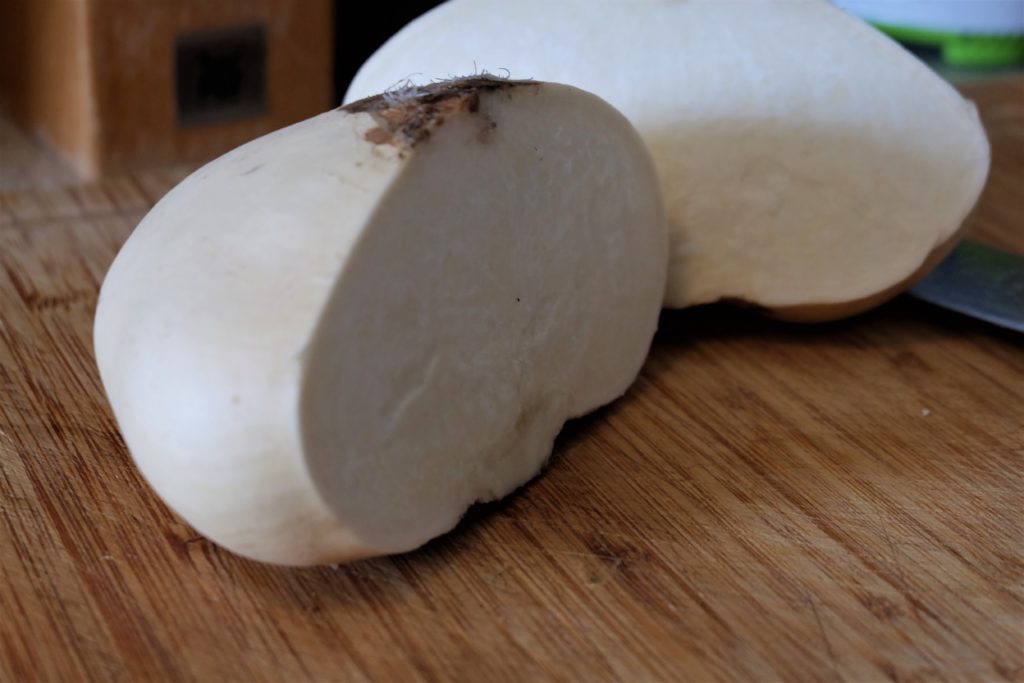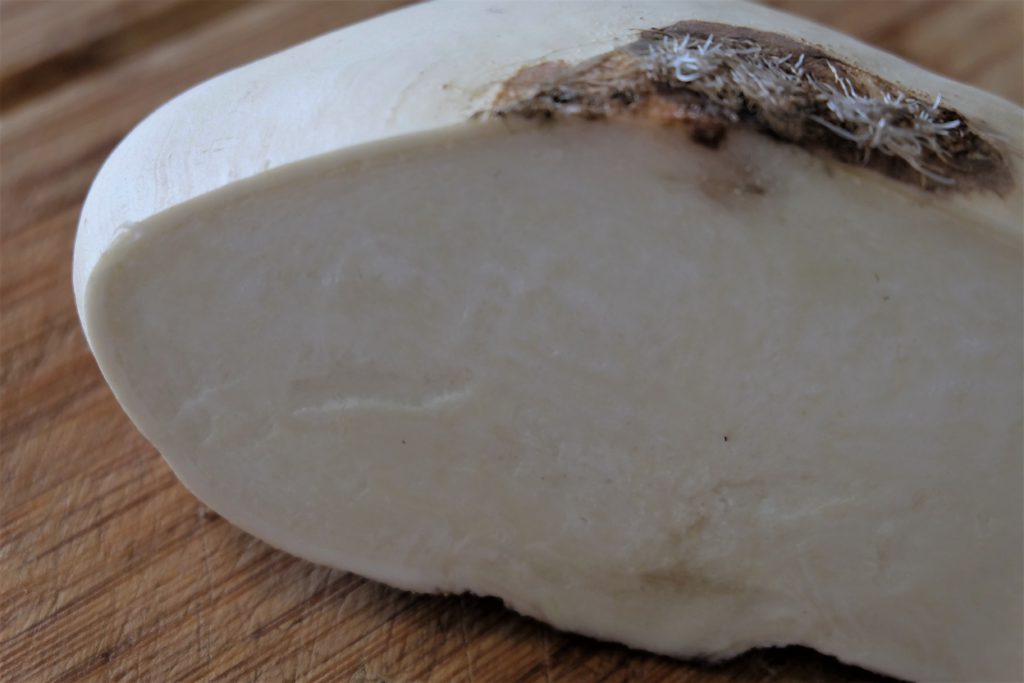- Latin : Brassica rapa L. subsp. Rapifera Matzg
- English:Chinese turnip
- Mandarin Chinese: Pancai 盘菜
- Literary Chinese: Wu Qing 芜菁, Man Qing 蔓菁
The turnip is a root vegetable originating from Europe, but it reached China very early on, around two thouand years ago. Today, the Chinese turnip is naturalised in China and is mainly grown and eaten in the Zhenan 浙南 region (the southern part of the Zhejiang 浙江 province that has a mild temperate climate).

How did Pancai 盘菜 the Chinese turnip come about?
According to the Chinese Physician Li Shizhen 李时珍 (1518-1593 AD), the Pancai came from the western region, namely modern Turkmenistan and Uzbekistan, in his Compendium of Materia Medica (本草纲目). It also infers that this could be the result of the alliance between the Han Emperor and the Turkic rulers around 140 BC.
The western Chinese provinces also calls the Pancai the “Zhuge Turnip” 诸葛菜, after the war strategist Zhu Geliang 诸葛亮 (181-234AD). According to legend, Zhu Geliang ordered the widespread planting of pancai after a locust-induced famine, because the vegetable is nourishing, grows fast and grows underground.
Why is the Pancai 盘菜 called the Chinese turnip?
The family of “Brassica” is wild mustard that spreads throughout the Eurasian continent. The turnip is a sub-family called “Brassica rapa”. This is the European turnip, a typical round European root that is purplish on top and white on the bottom.
Whilst the European turnip is rather sharp in flavour and smell, the Chinese cousin (or descendent) – the sub-species “Rapifera Matzg” is surprisingly mild.
The pancai is offwhite on the outside, much bigger and flatter than the European turnip. It is completely white on the inside and does not have the typical scent of its ancestor.
Why is the Pancai 盘菜 not better known?
There are several reasons why you do not often see the Pancai 盘菜 in Chinese supermarkets.
First of all, there is often a confusion between the English terms of turnip, radish and carrot whenever things are being translated from Chinese. This is because there is no clear definition for root vegetables in Chinese. So when searching for “Chinese turnips”, you end up seeing the Daikon (which is a kind of radish). And when searching for “Daikon”, you end up with dishes calling for “carrots” (a common mistake by non-English-speaking Singaporeans).
For clarity’s sake and for the education of these Singaporeans:
- Pancai 盘菜/ Wuqing 芜菁: Chinese turnip
- Bailuobo 白萝卜/蘿蔔: No English name exists so most English-speakers use the Japanese term, Daikon 大根
- Qingluobo 青萝卜/蘿蔔: A smaller greenish version of the Daikon
- Huluobo 胡萝卜/蘿蔔: Carrot
- Luobo 萝卜/蘿蔔: Radish Family
- Yingtao Luobo 樱桃萝卜/櫻桃蘿蔔: Garden radish
- Hongluobo 红萝卜/蘿蔔: A larger red version of the garden radish
Note: There is also a confusion amongst non-English speakers between the jicama and the Chinese turnip. Please see below.
The European turnip is not known by Chinese speakers, so any recipe calling for that needs to specify it is the “European turnip” and not the “Chinese turnip”. Likewise, the “garden radish” is a recent introduction, and its common English name “radish” will be misinterpreted by Chinese speakers as the daikon, because “radish” is a family of root vegetable (luobo) in their minds.
A typical Cantonese and Hokkien dish called Luobogao 萝卜/蘿蔔糕 is often mistranslated as “carrot cake” or “turnip cake”, because the recipe calls for the daikon.
Secondly, there was a gradual takeover of pancai recipes by the daikon.
For everything that calls for the daikon, you can easily replace it with the pancai.
But because the daikon has a stronger flavour, pancai has been losing grounds to it for a few generations.
The only place that is still eating lots of it is the southern region of the Zhejiang province.
Thirdly, in Southeast Asia, the Chinese turnip was taken over by the jicama (Pachyrhizus erosus), which many non-English-speaking Singaporeans still unwittingly call the “turnip”. The jicama belongs to the genus Pachyrhizus, and has nothing to do with the turnip, not in taste nor appearance. It has likely been misnamed the “Mexican turnip” in the US. Whilst the jicama indeed originates from Mexico, it is being widely used in Southeast Asia after European colonisation.
The jicama is the name of what the Hokkiens call “bang kuang”, a name taken over by the Indonesians while the Malays call it “ubi sengkuang”.
In Singapore and Malaysia, jicama has been used instead of pancai for the quintessential Hokkien dish of popiah. It is also used to make the Malay dish of rojak.

How do you eat Pancai 盘菜 the Chinese turnip?
As part of your salad: You can slice it or julian it and add it to your salad. Because it is so mild, it works better as non-invasive ingredient compared to the daikon.
As a pickle: You can pickle it in brine like the daikon
In a soup: Like the daikon, you can dice it and add it to a clear pork or chicken broth.
In a “cake”: Like the daikon, you can grind it down and add rice flour and mould it into a cake, that can be panfried or made into a crepe.
In a “springroll”: This is called Chunjuan in Chinese, Nem in Vietnamese, Loempia in Tagalog and Popiah in Hokkien. This is the original filling used by the Chinese, which in Southeast Asia now being replaced by the jicama.

